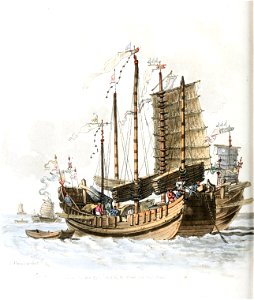Drawing by william alexander, draughtsman of the macartney embassy to china in 1793. Two chinese junks before departure on august 5, 1793 for the pay-ho, or white river in the gulf of pe-tchi-li. They carry the staff of the british embassy, presents for the chinese emperor, and embassy's luggage. Alexander described them as clumsily constructed; they held about two hundred tons each; being flat-bottomed, they draw but little water, and were able to cross the shallows at the entrances of the chinese rivers. The junks are of the same form at stem and stern, and the hold is divided into compartments, each being water-tight; the masts are of one tree, and very large; their main and fore sails are of matting, composed of split bamboos and reeds interwoven together; the mizen sails are of nankeen cloth. The rudders, which are generally lifted out of the water when at
anchor, are rudely formed, and cannot be worked with dexterity; the steering compasses are placed near them, and surrounded with perfumed matches. The anchor of four points is of iron, the other of wood; at the quarters are stowed some bamboo spars; and the junks are gaudily adorned with ensigns, vanes, etc. , to the chinese taste. Image taken from the costume of china, illustrated in forty-eight coloured engravings, published in london in 1805. Date: circa 1800.
Loading...
